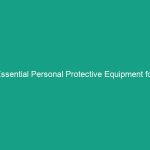Introduction
Good morning team! Today, we’re going to discuss an essential topic that affects each and every one of us—developing a Safety culture in our workplace. Understanding and prioritizing Safety is not just about following rules; it’s about creating an Environment where everyone feels responsible for their own well-being and the well-being of their colleagues. A strong safety culture can significantly reduce workplace accidents, injuries, and even save lives.
So, why is this topic important? Well, when safety becomes ingrained in our daily operations, it not only enhances our work environment but also boosts morale and productivity. Let’s dive in and explore the essential guidelines for developing a safety culture in your workplace!
Understanding Safety Culture
Safety culture refers to the attitudes, beliefs, and behaviors regarding safety within an organization. It encompasses how safety is prioritized, communicated, and practiced among all employees, from management to front-line workers. A positive safety culture is crucial because it fosters an environment where safety is a shared responsibility.
Unfortunately, many employees may misunderstand the concept of safety culture, believing it solely revolves around compliance with Regulations. In reality, it goes beyond that—it’s about fostering a proactive mindset where everyone feels empowered to speak up about safety concerns and contribute to improving safety practices.
Key Hazards, Risks, and Safety Considerations
Developing a safety culture means recognizing and addressing various Hazards and risks in the workplace. Common hazards may include:
- Slips, trips, and falls
- Hazardous materials
- Machine-related injuries
- Ergonomic issues
- Electrical Hazards
Ignoring safety protocols can lead to serious consequences, including injuries, lost work time, and higher insurance costs. For example, a slip and fall accident not only affects the injured employee but can also impact team productivity and morale. By developing a strong safety culture, we can mitigate these risks and ensure a safer work environment for everyone.
Best Practices, Procedures, & Actionable Advice
So, how can we cultivate a strong safety culture? Here are some essential Best Practices:
1. Leadership Commitment
Leadership must demonstrate a genuine commitment to safety. This includes establishing clear safety policies, providing necessary resources, and leading by example. When employees see management prioritizing safety, they are more likely to follow suit.
2. Open Communication
Encouraging open communication is vital for a safety culture. Employees should feel comfortable reporting hazards or unsafe practices without fear of retribution. Regular safety meetings and open-door policies can help foster this environment.
3. Training and Education
Regular safety Training is essential for all employees. Training should cover not only safety Procedures but also how to identify potential hazards. Real-life examples and case studies can make training more relatable and memorable.
4. Continuous Improvement
Safety culture is not static; it requires continuous improvement. Regularly review safety practices, conduct audits, and encourage feedback from employees. Use this information to refine procedures and make necessary changes.
5. Recognition and Rewards
Acknowledge and reward safe behaviors. Recognizing employees who prioritize safety can motivate others to do the same. Consider implementing safety awards or incentive programs to encourage participation.
Regulations, Standards, and Compliance
Understanding and complying with safety regulations is critical for any workplace. Relevant Standards may include:
- OSHA (Occupational Safety and Health Administration) standards
- ISO 45001 (Occupational Health and safety management systems)
- Company-specific safety policies and procedures
Compliance not only protects employees but also avoids potential legal issues and financial penalties. Regular training on these regulations ensures that everyone is informed and up-to-date.
Employee Engagement & Discussion
Now, let’s take a moment to discuss! What safety challenges have you encountered related to our current practices? Are there any suggestions you have for improving our Workplace Safety culture? Your input is invaluable, and together we can brainstorm solutions that enhance our safety culture.
Conclusion & Key Takeaways
In summary, developing a safety culture in our workplace is a shared responsibility that requires commitment, open communication, continuous improvement, and recognition of Safe Practices. By implementing these essential guidelines, we can create an environment where safety is a top priority and everyone feels empowered to contribute.
Remember, safety is not just a policy; it’s a mindset. Thank you for your attention and your commitment to making our workplace safer for everyone. Let’s prioritize safety every day!


